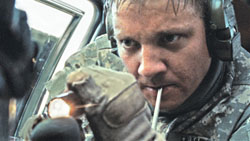There's a moment near the end of "The Hurt Locker," Kathryn Bigelow's masterful look at life and death on Baghdad's mean streets, where one American sergeant — a cool, tough professional on mission after mission — finally breaks down and loses it after yet another close brush with death. "Another two inches . . ." he sobs. "Shrapnel pierces my throat, I bleed out like a pig in the sand. And nobody gives a s--t!"
If there's a political statement contained in this film, that's it right there: Nobody gives a s--t. Part of "The Hurt Locker's" mission is to bring home the reality of Iraq deployments to a public that has been largely shielded from having to ponder the human cost of the war. But for the most part, Bigelow's film — unlike nearly every other Iraq war film, from "Lions for Lambs" to "Redacted" — manages to avoid polemics and remain tightly focused on the micro level, on the careful tracing of wires in the sand, or the wary scanning of rooftops with scopes.
This is a second generation Iraq war film: The whole question of "why we should/shouldn't be in Iraq" is practically a moot point. American soldiers walk down devastated streets, disarming an endless series of IEDs (improvised explosive devices), and car bombs, count the days until their tour is up, and view every Iraqi they see as a potential threat. Iraqis, glimpsed in windows and doorways, are just as wary of the Americans, viewing them with fear, curiosity or hostile intent. The gulf between them is immense. All that neocon talk about "flowers in the streets" and "an Iraqi Marshall Plan" now seems like so much la-la faerie-land head-tripping. The only goal left seems to be — survive.



















With your current subscription plan you can comment on stories. However, before writing your first comment, please create a display name in the Profile section of your subscriber account page.